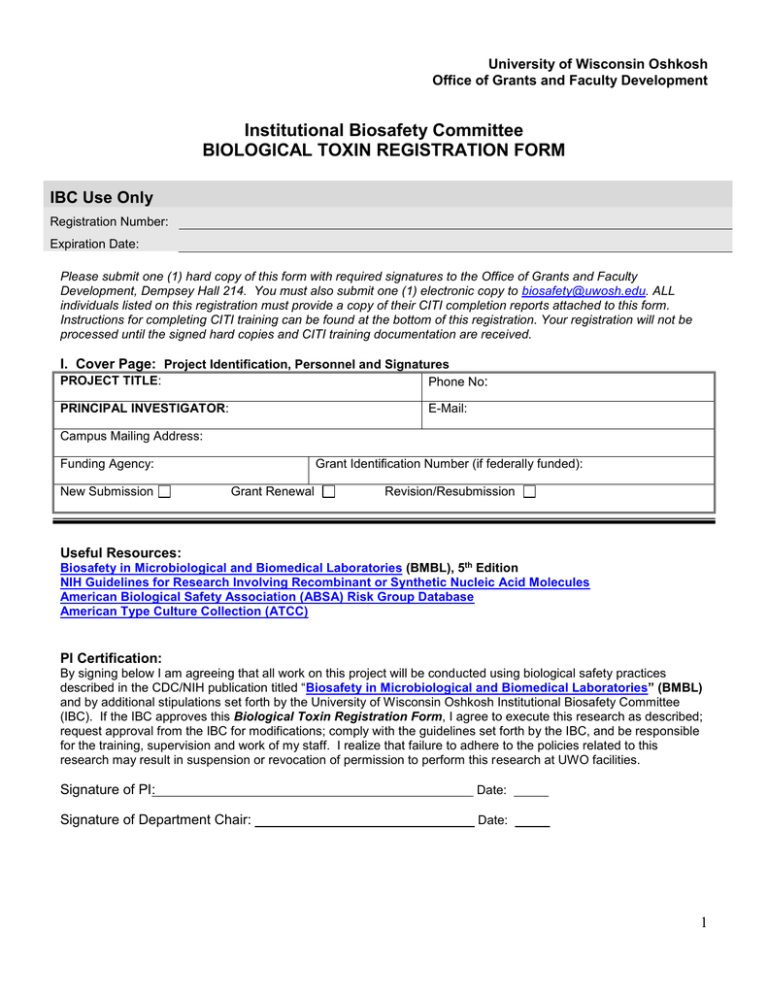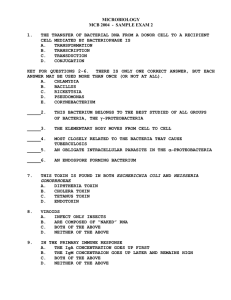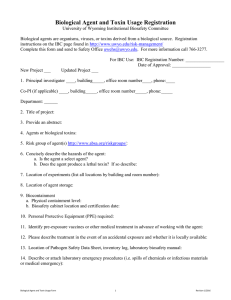Institutional Biosafety Committee BIOLOGICAL TOXIN REGISTRATION FORM IBC Use Only
advertisement

University of Wisconsin Oshkosh Office of Grants and Faculty Development Institutional Biosafety Committee BIOLOGICAL TOXIN REGISTRATION FORM IBC Use Only Registration Number: Expiration Date: Please submit one (1) hard copy of this form with required signatures to the Office of Grants and Faculty Development, Dempsey Hall 214. You must also submit one (1) electronic copy to biosafety@uwosh.edu. ALL individuals listed on this registration must provide a copy of their CITI completion reports attached to this form. Instructions for completing CITI training can be found at the bottom of this registration. Your registration will not be processed until the signed hard copies and CITI training documentation are received. I. Cover Page: Project Identification, Personnel and Signatures PROJECT TITLE: Phone No: PRINCIPAL INVESTIGATOR: E-Mail: Campus Mailing Address: Funding Agency: New Submission Grant Identification Number (if federally funded): Grant Renewal Revision/Resubmission Useful Resources: Biosafety in Microbiological and Biomedical Laboratories (BMBL), 5th Edition NIH Guidelines for Research Involving Recombinant or Synthetic Nucleic Acid Molecules American Biological Safety Association (ABSA) Risk Group Database American Type Culture Collection (ATCC) PI Certification: By signing below I am agreeing that all work on this project will be conducted using biological safety practices described in the CDC/NIH publication titled “Biosafety in Microbiological and Biomedical Laboratories” (BMBL) and by additional stipulations set forth by the University of Wisconsin Oshkosh Institutional Biosafety Committee (IBC). If the IBC approves this Biological Toxin Registration Form, I agree to execute this research as described; request approval from the IBC for modifications; comply with the guidelines set forth by the IBC, and be responsible for the training, supervision and work of my staff. I realize that failure to adhere to the policies related to this research may result in suspension or revocation of permission to perform this research at UWO facilities. Signature of PI: Date: Signature of Department Chair: Date: 1 Important Information Before you Begin: Standard Laboratory Practices for Biological Toxin Work All Biological Toxin use must be registered with the IBC A minimum of Biosafety Level 2 practices and containment will be used for activities involving biological toxins, following institutional policy. Biohazard signs and labels must be displayed in areas and on equipment where use and storage of biological toxins occur (i.e. laboratory entranceways, biological safety cabinets, freezers, refrigerators, etc.) When biological toxins are in use, a sign must be displayed on the lab entranceway stating “Toxins in Use: Restricted Entry” Use of a biological safety cabinet (BSC) or a chemical fume hood for resuspension of biological toxins or manipulations of stock solutions of toxins that can generate aerosols is required View Appendix A “Examples of Biological Toxins and LD50 Information” for a list of examples of biological toxins and their LD50 values II. Research Personnel A. Identify personnel conducting the experiments (including students). Specify Name, Degree, CITI Training Completion Date, and Project Responsibilities. Name Degree CITI Training Completion Project Responsibilities Date Attach a separate sheet if more space is required B. Provide details on the type(s) of project-specific training all personnel listed in IV.A. above have received. Include hands-on training, training via supervisor, workshops, etc. III. Animal Use Any use of animals for research, teaching or testing purposes must receive approval from the UW Oshkosh Institutional Animal Care and Use Committee (IACUC) prior to Institutional Biosafety Committee (IBC) approval. The IACUC requires that the researcher submit an IACUC Protocol Application for approval of animal use. Contact iacuc@uwosh.edu for more information. IACUC forms can be found at www.uwosh.edu/grants/forms. Please note that the IACUC holds 1-4 meetings per semester and requires the PI to submit protocol applications at minimum two weeks before the next scheduled meeting. IACUC meeting dates can be found at: www.uwosh.edu/grants/iacuc-meeting-dates 2 A. Does the experiment involve the infection and/or use of animals? Yes No If “Yes”, you must have an approved IACUC Protocol Application on file with the IACUC office prior to beginning work with toxins. Contact iacuc@uwosh.edu for more details. B. List animal specie(s) to be used in the proposed work and explain how use of this particular specie(s) is scientifically justified: IV. Project Summary* A. Provide a brief description of the proposed research or teaching activity in such a way that a scientist in another field will understand (layman’s terms). You must include the following: 1. Brief Introduction, 2. Goals/Purpose, 3. Experimental Methods to Be Used, and 4. Outcomes to be Measured. You can find an example list of toxins and quantities that would require registration with the UW Oshkosh IBC in Appendix A: “Biological Toxins Requiring an IBC Protocol.” *If working with animals you must first receive prior approval from the Institutional Animal Care and Use Committee (IACUC) V. LD50 and Quantity Information A. Provide mammalian LD50 information for any biological toxins proposed for use. Information on LD50 for certain biological toxins can be found in Appendix A. This information may also be available in a Safety Data Sheet (SDS) provided by the source company. Definition: Lethal Dose 50 (LD50): the amount of a toxin that is sufficient to kill 50 percent of a population of animals within a given time B. What amount of biological toxin will you have in stock at any given time? VI. Source A. Explain how the toxin will be acquired: 3 Laboratory Stock Off-campus Collection Off-campus Researcher Directly from animal/plant tissues Other (describe): B. Provide further explanation of source, if needed: VII. Transportation A. Will biological toxins be transported between locations (i.e. between labs in the same building, between different buildings on campus, between campus and satellite off-campus locations)? No Yes B. If “Yes”, please explain transportation procedures: VIII Storage and Security A. Explain how the toxin will be stored and maintained while at UW Oshkosh facilities. Include information on security to ensure unauthorized people cannot access the toxin: Lypholized Chemical-fixation Refrigerator (Provide location: ) Freezer (Provide location: ) Storage Cabinet (Provide location: ) Incubator (Provide location: ) In vivo (Also complete Appendix A) Other (describe): B. Provide further explanation of storage conditions, if needed: C. Will storage space(s) be secured or locked? Provide explanation including who will have access to the toxin(s): 4 VIX. Disposal A. Explain how materials containing the biological toxin are inactivated and disposed. If a chemical disinfectant is used, state the kind and concentration. Explain how liquid waste and/or solid waste contaminated with toxin will be inactivated and disposed of, as applicable. Reference: http://www.uwosh.edu/ehs/environmental Additional information may also be found in Section VIII-G of the 5th Edition of the BMBL X. Personal Protective Equipment A. Select the personal protective equipment (PPE) to be worn for the procedures described on this form. Questions regarding PPE requirements should be directed to biosafety@uwosh.edu Important: For work with biological toxins, a minimum of disposable gloves, lab coat, and eye protection (safety glasses or goggles) are required Hand Protection Examination gloves Heat resistant gloves Cold resistant gloves Eye Protection Safety glasses Goggles Face shield Goggles + Face shield Body Laboratory coat (white) Scrubs Blue smock/coveralls Tyvek body suit Waterproof boots Hair Hair cover/hat Respiratory Guidance on respirator selection can be found at: 100.pdf N-95 mask Air purifying respirator (half mask/particulate) Air-supplied respirator http://www.cdc.gov/niosh/docs/2005-100/pdfs/2005- Other (Explain): B. Provide additional information, if needed, on PPE use for the proposed work: 5 XI. Safety Equipment A. Select the safety equipment to be utilized for the procedures described on this form. Biosafety Cabinet: Autoclave: Will your work require use of an autoclave? Cabinet Class: I II III Yes No Model: Autoclave Location: Cabinet Location: Certification Date**: Other Equipment (Explain): ** Biosafety cabinets under regular use must be certified on an annual basis by experienced personnel or through a contracted and licensed company. Class I cabinets are ventilated for personnel protection and have an inward flow of air away from operator. Exhaust air is filtered through a HEPA filter. Class II cabinets are ventilated for personnel and product protection having an open front with inward air flow for personnel protection, and HEPA filtered mass recirculated air flor for product protection. Exhaust air is filtered through a HEPA filter. Class III cabinets are closed-front ventilated cabinets with gas tight construction which provide the highest level of personnel protection. The cabinet is fitted with arm-length rubber gloves and is operated under negative pressure. All supply air is filtered through HEPA filters. Exhaust air is filtered through two HEPA filters or one HEPA filter and one incinerator. Emergency Preparedness This section requests a summary of all emergency response plans that are in place for your laboratory or work space. XII. Emergency Contact information A. Provide emergency contact information for the following: i. PI and Research Staff ii. Program Staff iii. Student Health Center, personal physician or physician familiar with toxin, Environmental Health and Safety, chemical disposal contact or company, etc. XIII. Associated Health Risks A. Describe the health risks, as applicable, associated with the toxin(s) you will use. Include information on available vaccines and their recommended use for persons handling the toxin. 6 XIV. Potential Exposure Hazards A. Identify potential exposure hazards (e.g., aerosol generation when transferring, mixing, or centrifuging, accidental inoculation, ingestion, use of needles/sharps, etc.). If toxins will be used in animals, be sure to specify additional risks related to animal handling, husbandry or by-products. B. Explain the procedure for mitigation if an exposure were to occur. How will personnel health/safety be protected? XV. Accidental Spill and Containment Breach Response A. Provide a spill response and/or containment breach procedure, as applicable, that will be utilized in the event of a spill or breach. What steps will be taken to ensure the spill or breach is contained? Who will be contacted? XVI. Violations to Safety Protocol A. Explain what steps will be taken if personnel are found to be performing work out of compliance with established laboratory safety protocols or procedures. Please note that any incidents such as exposures, personal injury (needle stick), accidental spills, or containment breaches where biological toxins are utilized must be reported to the Institutional Biosafety Committee within 24 hours by completing the IBC Incident Report form and e-mailing to biosafety@uwosh.edu FOR IBC USE ONLY: Reviewer’s Recommendations: 7 Designated Reviewer requests Full Committee Review Designated Reviewer Requests Further Information (Explain below) Designated Reviewer Requests Consultation from Ad Hoc Consultant (Explain Below) Designated Reviewer is satisfied with the Biological Toxin Registration and safety plan. Additional Information (Explain below): Designated Reviewer Name: Review Date: Full Committee Review Determination: Review Date: Instructions for CITI Training for Biosafety and Security Program (BSS): 1. Enter the training at www.citiprogram.org a. Select: New Users Register Here b. Create your profile and affiliate with University of Wisconsin Oshkosh. c. You will be prompted by response driven questions that will determine what course and modules you will be required to complete based on your role in the Biosafety and Security Program. a. Example: If you are a committee member and a faculty researcher on campus, answer the questions according to both of your roles. d. The program will provide you with a customized list of courses to complete. The course list will appear on your Main Menu page. e. You can enter the training by clicking on any of the courses listed in your Main Menu. Each course is compiled of numerous modules. There is typically a short quiz after each module. You must complete the quizzes to earn credit for the course. 2. Training may take 1-3 hours to complete depending on your role(s) in the program, so please plan accordingly. 3. At the completion of the training, a completion report is issued verifying the curriculum completed. A hard copy of the Training Certificate must be attached to the protocol application or registration form that you submit to the IBC. 4. The CITI Program training is valid for three (3) years. A refresher course will be required at the time of expiration for continuing projects. 5. For more information or questions about the CITI training requirement, please contact: IBC Administration: biosafety@uwosh.edu 8 Appendix A: Examples of Biological Toxins and LD50 Information Biological Toxin LD50 (ug/kg) Abrin* 0.7 Aerolysin 7 Botulinum toxin A* and B* 0.0012 Botulinum toxin C1* 0.0011 Botulinum toxin C2* 0.0012 Botulinum toxin D* 0.0004 Botulinum toxin E* 0.0011 Botulinum toxin F* 0.0025 b-bungarotoxin 14 Caeruleotoxin 53 Cereolysin 40-80 Cholera toxin 250 Clostridium difficile enterotoxin A 0.5 Clostridium perfringens lecithinase 3 Clostridium perfringens perfringolysin O 13-16 Clostridium perfringens delta toxin 5 Clostridium perfringens epsilon toxin 0.1 Conotoxin (only short, paralytic alpha conotoxins with specific 12-30 sequences are considered Select Agents)* Crotoxin 12-30 Diacetoxyscirpenol* 1000-10,000 Diptheria toxin* 0.1 HT-2 toxin 5-10 Leucocidin 50 Listeriolysin 3-12 Modeccin 1-10 Nematocyst toxins 33-70 Notexin 25 Pertussis toxin 15 Pneumolysin 1.5 Pseudomonas aeruginosa toxin A 2.7 Ricin* 2.7 Saxitoxin* 8 Shiga toxin 0.25 Shigella dysenteriae neurotoxin 1.3 Staphyloccal aureus toxins* 2-25 Staphylococcus enterotoxin B* 25 Staphylococcus enterotoxin F 2-10 Staphylococcus enterotoxins A, C, D, and E* 20(A); <50(C) Streptolysin O 8 Streptolysin S 25 T-2 toxin * 5,000-10,000 Taipoxin 2 Tetanus toxin 0.001 T-2 toxin* 5-10 Tetrodotoxin* 8 Volkensin toxin 1.4 Yersinia pestis murine toxin 10 This table was developed from those created by University of Florida Environmental Health and Safety Office and Oregon Health & Science University * Toxins designated with an asterisk (*) are considered Select Agents by the Federal Government if kept by a PI at or above the quantities listed in the table. If you plan to work with any toxins designated with a *, please contact the IBC office at biosafety@uwosh.edu 9



